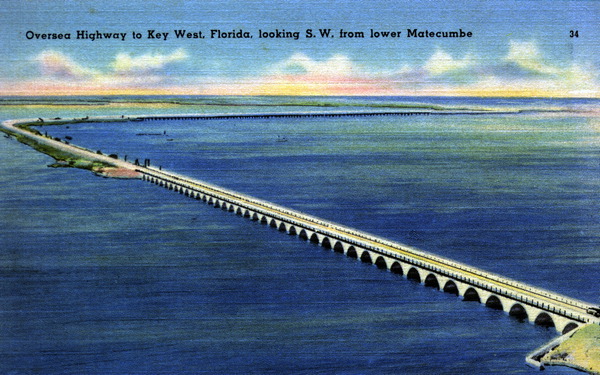They called it "Flagler's Folly," the wondrous work of concrete, steel and wood stretching 128 miles from the Florida mainland to Key West, in a place where nature never intended for a railroad to run.
But exactly 100 years ago Sunday at 10:43 a.m., a 110-ton Schenectady-built locomotive, powered by steam heated by oil, rolled over the last length of track on a dusty and stark Key West, bearing the ailing man dubbed the island's savior, oil baron Henry Flagler. He was greeted by applause, cheers, band music and choirs of schoolchildren, this man whose final dream was realized by the completion of his Florida East Coast Railway's Key West extension.
A parade in Old Town today will mark the completion of the railroad, which launched an already prosperous city into a new era, linking it to the continental rest of the U.S. and promising a jumping off point for commerce headed to the Panama Canal and the island of Cuba.
"We'll be celebrating Flagler's great accomplishment, a very important landmark in the city's history," Key West spokeswoman Alyson Crean said. "It has definitely shaped who we are as a city. Before the railroad, everything had to be shipped in. It was one man's extraordinary expenditure to do something just because he could do it. It probably couldn't happen in any other age."
Only a handful of people who remember the railroad's inaugural arrival still live. But their memories have been tapped by event organizers and news media outlets all month in preparation for the grand centennial of the railroad's maiden run.
Lamar Louise Curry, 105, who now lives in Coral Gables, watched the railroad being built and was slated to take part in the arrival festivities. The then-5-year-old Curry was supposed to bear flowers as a gift for Flagler's wife, Mary Lily, when she disembarked from the train.
Years later she often road the Florida Keys Over-Sea Railroad.
"It was very exciting, because I looked out the window the whole time while we were on the trestle," she said. "So it was a wonderful occasion to ride over it."
Minnie Dameron, now 87, who also remembers riding the railroad as a girl, will be co-grand marshal of today's parade with re-enactor Artie Engler, who has been at railroad-related events this month representing himself as Flagler.
Dameron, who lived on Plantation Key as a girl, was on the train when it made its final journey, just before major damage occurred to its tracks from a 1935 Labor Day hurricane that rendered the railroad useless.
"My sister and I used to love to ride the train and look out the window," Dameron said. "But when we'd come to the Seven Mile Bridge, it looked like you were riding on the water, so we'd get scared and hold one another's hand."
The railroad was built at a cost greater than dollars.
Workers recruited from throughout the U.S., the Bahamas and other places worked in fetid swamps and risked yellow fever, although reports indicate they were fed well and that efforts were made to keep them happy and comfortable.
In 1906, a hurricane set adrift boats that were used as worker barracks, killing 135. A 1909 hurricane claimed 14 lives, and others died in general industrial accidents along the route.
A total of 42 million pounds of steel and 96,000 tons of concrete were used to build bridges and the track bed; 78,000 pilings were employed.
Flagler's arrival on the first train to reach Key West was chronicled by The Key West Citizen. The front-page story says the train arrived amid "the roar of bursting bombs, the playing of bands, the shrill screeches of whistles, the cheering of thousands of people and the waving of countless American flags."
Accompanying Flagler were personal envoys on behalf of President William Howard Taft, ranking Navy and Army officials and other "distinguished guests."
A poem by J.B. Killegrew, dedicated to Flagler, graced the front page as well.
"Far down the sunlit golden sands/Lie gleaming rails, the twin steel bands/Of Commerce spanning verdant isles/Running o'er the sea miles on miles ..."
Ships from Cuba, Portugal and various U.S. ports of call were in Key West's harbor 100 years ago this weekend to celebrate the railroad, including a Cuban gunboat called the Hatuey. Representatives of the Cuban government who had come to celebrate the event went to a ball thrown in their honor.
"Now I can die happy," Flagler is reported to have said once the railroad was finished.
Within 16 months, that statement became a prophecy, when the father of modern Florida died in his palatial Palm Beach home.
Today's parade starts at about 1 p.m. at Southard and Whitehead streets, takes a left from Whitehead to Angela Street, a left onto Duval Street and a left at Front Street, where it will end at the Custom House.

.
 Henry M. Flagler
Henry M. Flagler Chief Engineer William Krome
Chief Engineer William Krome





 isn't that the truth...
isn't that the truth...


